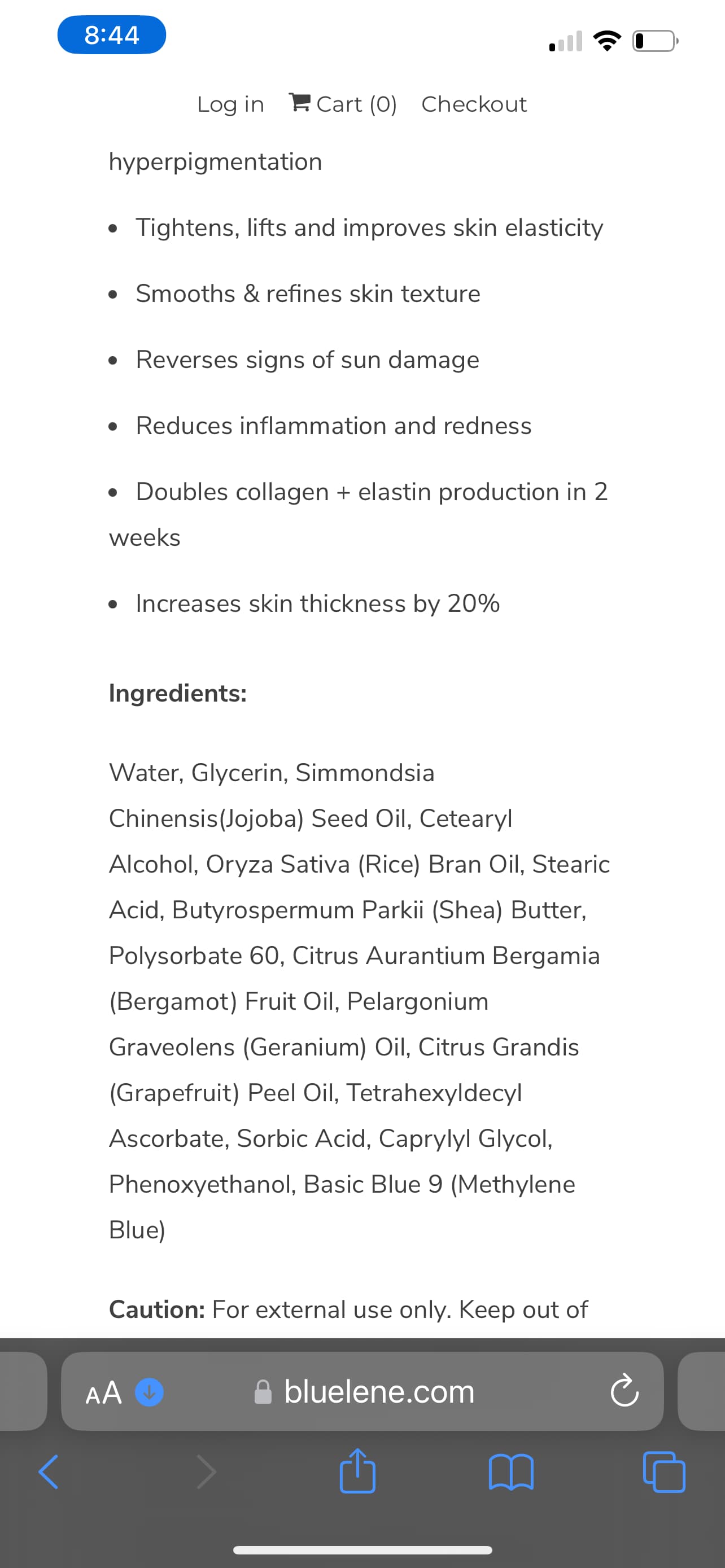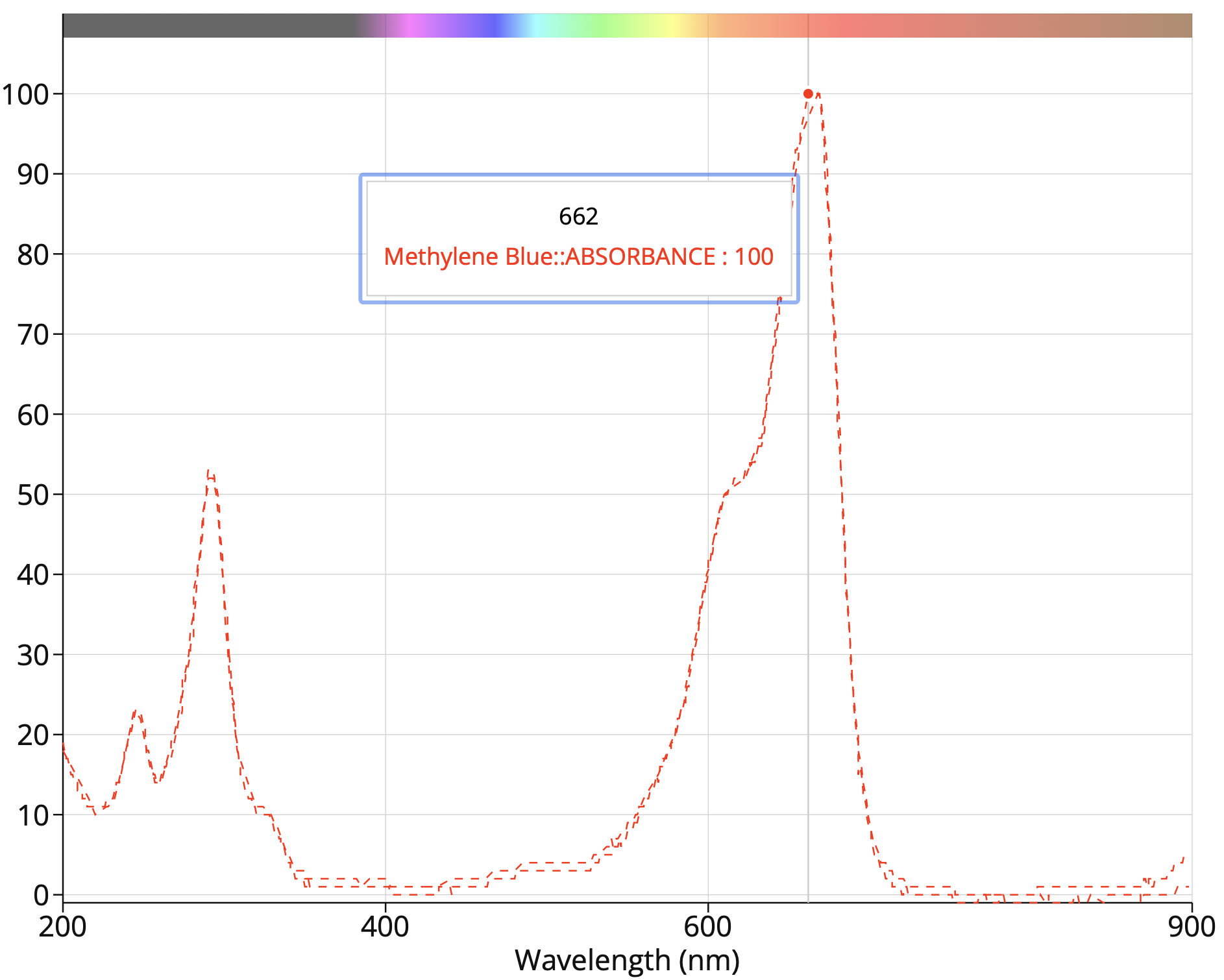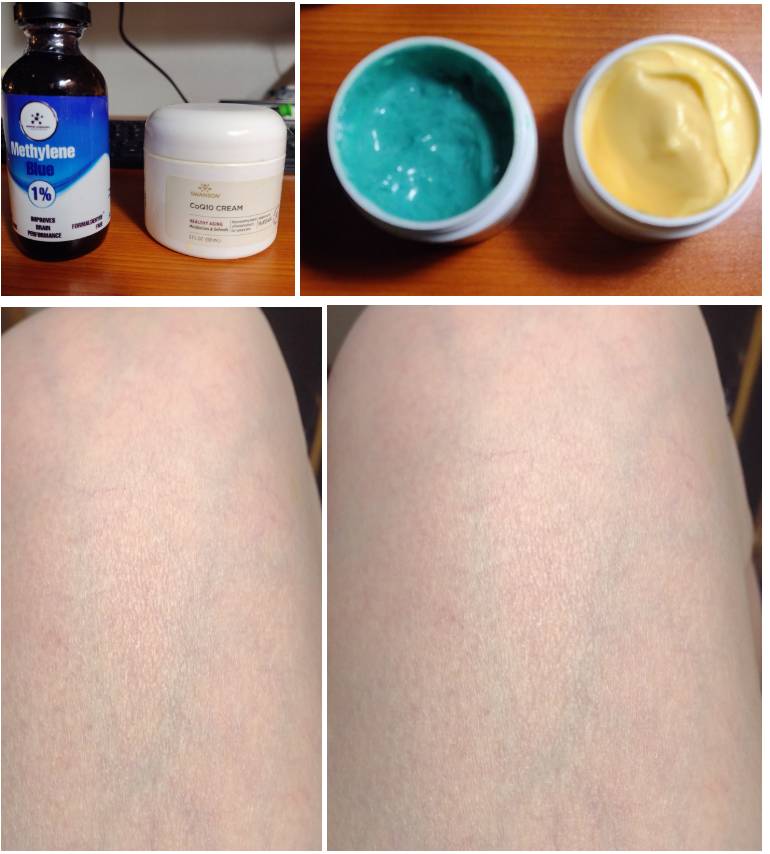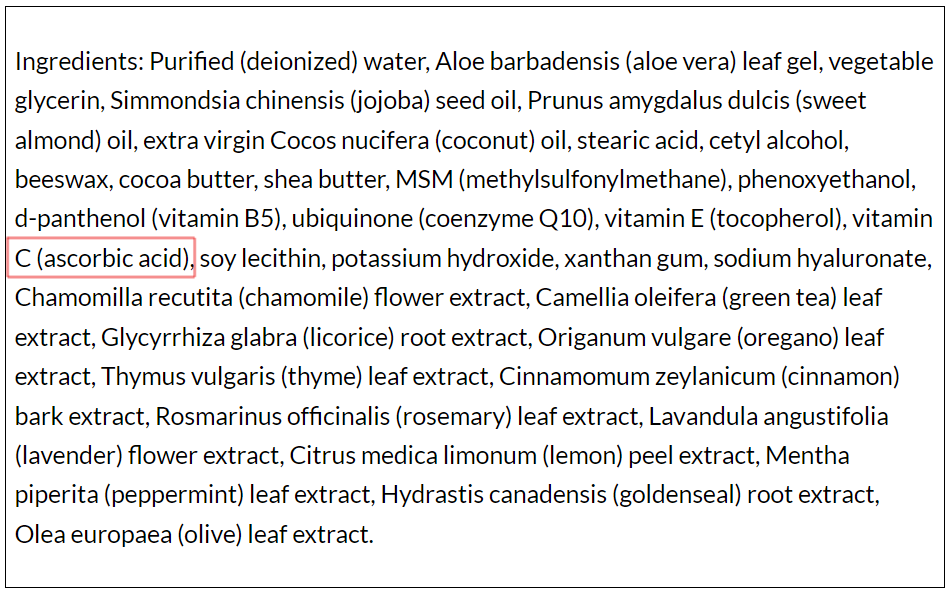John Hemming, With the brand in this Amazon link (Biopharm) each drop contains 0.5 mg. Look at the left-hand side of the screen, the 5th miniature image from the top if you click the link. I tried to copy and paste the image, but was not successful.
A couple of drops, therefore, is 1mg. AIUI recommended low dosage is more like 15-20mg per day.
John Hemming, This video may give more information on appropriate dosage. I think it’s the right video, but I’m not sure because it’s been some time since I investigated Methylene Blue. And, for me, at a dose of 10 mg daily (20 drops) it did nothing. However, I noticed a decrease in stamina for about a week after I stopped, but there may have certainly been any number of reasons for that. Of course, I’m talking about oral, not topical, use here.
The lack of blue color of the Bluelene methylene blue skin cream isn’t necessarily a sign that the concentration of methylene blue in their cream is so low. It might also be a sign that they used leukomethlene blue in their cream instead of methylene blue.
Note that methylene blue can be reduced to leucomethylene blue and leucomethylene blue can be converted by oxidation back to methylene blue. This back and forth conversion occurs in the body. Importantly, while methylene blue has a blue color, leucomethylene blue is colorless, so if they are using leucomethylene blue instead of methylene blue it’s quite clear why their cream lacks a blue color.
There are good reasons why they might want to use leucomethylene blue instead of methylene blue. Methylene blue is highly water soluble and as such wouldn’t be expected to be absorbed through the skin. Leucomethylene blue is more fat soluble than methylene blue and as such has higher chances of penetrating the skin. I doubt methylene blue will be absorbed in significant amounts even if you use a high dose of it. Skin product formulation is a complicated problem. I would have more confidence in some formulated cream like Bluelene working rather than simply applying unformulated methylene blue to the skin.
All sounds very probable but I went and looked at their signature product, priced at $108 for 1.7 oz and they explicitly list Basic Blue 9 / methylene blue, in their ingredients. At the very bottom of the list, after phenoxyethanol, which is a preservative and typically used in concentrations of 0.046%….
My cheap basic cream (Gold Bond or Eucerin) with a couple of drops of MB works wonders for me personally. I think the red light panel is powerfully synergistic with it and somehow aids in absorption because my face has a slight blue tint when I get in front of the panel but no trace of blue is left when I’m done after 30 min. Does it evaporate?
Percutaneous absorption of active ingredients is fraught and unpredictable. Yes all things equal lipophilic compounds stand a better chance of making it through the barrier but there are other mechanisms too, such as aquaporins, which are friendly to glycerol penetration.
A primer:
I also use microcurrent devices that aid with absorption via alleged iontophoresis. Not sure if they do what they claim but the overall proof is in the pudding. My skin has not looked better.
I’ll try it! Where do you get MB?
Methylene blue is a classical photosensitizer used with 660nm light.
It’s used for antimicrobial and anti cancerous photodynamic therapy:
Photodynamic therapy (PDT) is a two-stage treatment that combines light energy with a drug (photosensitizer) designed to destroy cancerous and precancerous cells after light activation. Photosensitizers are activated by a specific wavelength of light energy, usually from a laser. The photosensitizer is nontoxic until it is activated by light. However, after light activation, the photosensitizer becomes toxic to the targeted tissue.
Several photosensitizer drugs are available today to treat a variety of diseases, including acne, psoriasis, age-related macular degeneration, and several cancers, such as skin, lung, brain, bladder, pancreas, bile duct, esophagus, and head and neck.
In addition to treating these conditions, PDT also helps treat bacterial, fungal and viral infections. Studies have shown that this light-based therapy can trigger the body’s immune response, giving your body another means to help destroy cancerous and precancerous cells.
Methylene blue (MB), also known as methylthioninium chloride, is a hydrophilic phenothiazine derivative. It is a photosensitizer with light absorption at 660 nm
Basically Photodynamic therapy is like photobiomodulation (Red/IR light therapy) on steroids.
Thanks for the info on the concentration in the Bluelene cream. It does indeed seem very low. That’s not necessarily a bad thing though, because there appears to be an U shaped dose response according to some studies I’ve seen. That also matches with what you said.
Interesting. I just realized something that might explain this. Methylene blue actually absorbs light of the visible spectrum including red light. The absorption of light by methylene blue can lead to photochemical reduction of methylene blue into leucomethylene blue. So there is a possibility here that the strong red light form the red light panel is causing the methylene blue to convert into leucomethylene blue. That could explain why you notice the blue color disappearing. That could also lead to increased absorption of methylene blue as the leucomethylene blue form that’s more lipid soluble. If that is happening, that could explain some of your benefits. This is my speculation.
Are you aware of other people reporting that using red light right after applying methylene blue to the skin results in increased effectiveness?
I get mine on Amazon, this product specifically but I don’t really think the brand matters. What matters is having a red light panel to use it with. Mine has 5 wavelengths, 660 nm among them. It’s as @cl-user said, photobiomodulation on steroids. I’m turning into a true narcissist, can hardly walk away from the mirror when I’m done.
I heard rumors to such effect on a skincare FB group but don’t recall seeing any actual research to back it up, except a version of what was listed before, of MB being a photosensitizer absorbing certain wavelengths in the red or near infrared spectrum. I decided to try it and boy am I glad I did.
medaura, If there is a small amount of vitamin C in any of the ingredients you listed it would react with the methylene blue to form leucomethylene blue which is as clear as water.
There might be! Need to look at the Eucerin / Gold Bond formula, there probably is. Either way, it’s like a witches’ facial, but only worth raving about when I use the red light. Otherwise it’s just fine, but not extraordinary.
That could happen but it’s not that simple. Vitamin C could help convert the methylene blue to leucomethylene blue but whether that happens depends on more factors such as the pH of the solution.
Actually I got reminded this morning when I used my Eucerin that it can’t be happening. Why? It’s blue in the jar and I already dropped the MB drops weeks ago. Nothing is happening in the jar conversion wise. It’s only happening on my skin, if that’s what’s happening at all.
You need the MB to be in its normal blue form for the Photodynamic therapy to work as it absorbs 98% of the light at 662~665nm. The absorption spectrum is pretty narrow so it’s pretty much only 660nm.
BTW no absorption at all in the IR 850nm band.
Here is how it works:
Photodynamic therapy (PDT) requires three components, the photosensitizer, oxygen, and light source [4]. The basic principle of PDT is energy transfer from the photosensitizer to oxygen in the tissue under light excitation. Under light excitation, reactive oxygen species, especially singlet oxygen, are generated which cause cellular toxicity.
[…]Methylene blue (MB), also known as methylthioninium chloride, is a hydrophilic phenothiazine derivative. It is a photosensitizer with light absorption at 660 nm.
[…] MB is used for antimicrobial photodynamic therapy (APDT) and is used as a potent PDT drug for local treatment of periodontal diseases [15], because of its efficiency against a broad spectrum of microbes including bacteria, fungi, and viruses [18,19].
[…]MB concentrations used in clinical studies ranged from 100 µg/mL [22] to 10 µg/mL [23].
Looks like it’s a typo and should be “to 10mg/mL”
Methylene blue is such a potent dye, that I fail to see how any significant amount of regular methylene blue would not color the lotion/cream.
Since I take methylene blue daily (10mg) I have some on hand. In the interest of science: ![]() I decided to add some to my current favorite skin cream.
I decided to add some to my current favorite skin cream.
So, I added 4 drops (~2mg) of methylene blue. The cream is of a nice golden yellow color so of course it turned the mixture blue/green. I added 10 mg of Transcutol because the cream was a little thick.
Then I tested the cream on my white bare leg first to see if I could see it giving my skin a blue/green tone. It did not, and I applied an ample amount. Of course, when you apply almost any lotion or cream it is quickly absorbed and only a fine layer remains on the skin.
I am posting (possibly disturbing) pictures of the before and after.
I think I could add significantly more methylene blue before I would see a tint to the skin.
(My daughter would be sure to tell me if she noticed a change)
The cream I used is from Swanson and does contain some vitamin C plus a kitchen sink full of other ingredients.
My plan is to apply the cream daily to all sun-exposed skin and do 40 minutes of (20 min front and back) full body red light photobiomodulation. My lamps claim to output at 660 nm.
I will try to do it every day for 30 days and see if I can see some subjective results.
My thought is: If your cream does not have a distinctive blue tint, it contains very little or no basic methylene blue.
Be careful though that methylene blue photodynamic therapy is used, among other things, for hair removal by destroying the hair follicles.
Results: Methylene blue (MB) is selectively absorbed by actively growing hair follicles due to its cationic property. Methylene blue (MB) untreated sections showed that hair follicle and sebaceous gland are intact and there is no change due to the laser exposure. Free methylene blue (MB) sections incubated for 3 h showed that He:Ne laser induced destruction in hair follicles, leaving an intact epidermis. Treated section with free methylene blue (MB) for 4 h showed degeneration and necrosis in hair follicle, leaving an intact epidermis.
Since I have no hair, no problem.
Though, you wouldn’t be putting it in your hair.
Since growing a beard is the last thing I want happening to my face, this is all a-OK with me.
Also I’m not sure if it’s doing anything long term to the skin but if my results are universally replicable, it should be offered as one of those last minute treatments before a photo op or big event, a bride’s facial or what have you, as it’s got short term noticeable effects.
Could you pls post the link to your red light panel? I am so confused, too many choices… would really help! thnx ![]()



